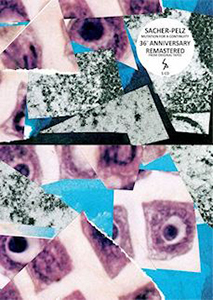Sacher-Pelz, "Mutation for a Continuity"
 Before Maurizio Bianchi was recording as M.B., or under his own name, he released a series of four tapes as Sacher-Pelz. In a short span between August 1979 and March 1980, his output showed the development from seemingly random, sloppy tape manipulations into something structured and composed, and a direct precursor to what would define Bianchi's work in the early 1980s. Reissued for the material’s 36th anniversary and expanded with the M.B. Plays Sacher-Pelz album, this set captures material that is both historically relevant, and exceptionally strong proto-noise music.
Before Maurizio Bianchi was recording as M.B., or under his own name, he released a series of four tapes as Sacher-Pelz. In a short span between August 1979 and March 1980, his output showed the development from seemingly random, sloppy tape manipulations into something structured and composed, and a direct precursor to what would define Bianchi's work in the early 1980s. Reissued for the material’s 36th anniversary and expanded with the M.B. Plays Sacher-Pelz album, this set captures material that is both historically relevant, and exceptionally strong proto-noise music.
The first four discs were previously released by a subsidiary of Alga Marghen, who also did the two ArcheoMB boxes in the late 1990s.This set specifies that it is remastered from the original tapes, but not having the original box set I am not sure how they compare.Being lo-fi cassette tapes recorded at home, a certain analog sheen (more like a fuzzy blur) covers these tapes.The earliest material, Cainus, is where this is most obvious.A claustrophobic, bass heavy rumble covers all seven pieces, with what sounds like pre-recorded music or synth sequences being sped up or slowed down via tape, sometimes coming to a complete and abrupt stop without following any overt sort of structure or template.
Even as soon as the second tape, Venus, Bianchi's work shows major strides forward in terms of structure and composition.The lengthy "La Cartilage Palpitant" has him blending deep thumping rhythms and radar beacon-like electronic pulses into a mass that slowly evolves and expands throughout its duration."Chains & Whips" (Bianchi was establishing his identity in the genre, and like many artists flirted with sexually deviant imagery) has a similar trajectory, beginning with an erratic stuttering rhythm that is slowly fleshed out with echoing synth noises and distortion.A piece such as "Numb Creature" demonstrates more of his expanding compositional skill, but still mixed with a lot of rudimentary, basic tape effects.
A few months later, on the Manson-centric Cease to Exist (again trying to find his niche), Bianchi's working with a wider array of electronic sounds, and relying less on his penchant for start/stop tape manipulations.The faster paced, jerky "In Dem Tod-Tal" has an almost thrashy edge to it that at times is reminiscent with the contemporary SPK single "Slogun", though admittedly buried deep amongst heavy bass and processing.Even though obvious bits of electronic organ may shine through, "Exterminas" results in mostly a sustained wall of harsh noise type piece.The bulk of the piece is layers of static laden distortion and sheets of white noise, hinting at the sound he would expand upon soon after.
With the final tape, Velours, the sound he would take on a year later as M.B. with Symphony for a Genocide becomes rather apparent.The 31 minute "Excitements" is a amalgamation ofpunchy distorted rhythms and what sounds like heavily effected piano in a grey, bleak composition that evolves and develops brilliantly throughout.The dense industrial crunch of "Sans Sang" and thudding drum machine of "Orphelin" also foreshadow the dark, depressive atmospheres he would soon become synonymous with, and continues to be to this day.
This newer reissue of the Sacher-Peltz material contains a fifth disc, M.B. Plays Sacher-Pelz, recorded in 2008.From the bits of glitch and digital stuttering I hear throughout these three lengthy pieces, I am going to assume that Bianchi constructed this material via a dual deck DJ CD player setup, working with the original work as source material.The result is a series of pieces that, while repetitive, have him finding memorable rhythmic segments in the originally murky, raw pieces.The structure may differ, but Bianchi hardly changes the original oppressive atmospheres (other than the end of the third untitled piece) and thus this added material, recorded 28 years after the fact, still feels like it belongs.
Maurizio Bianchi's work as M.B. during the early 1980s may be what he is most well known for, and those early albums are inarguably ones that helped to shape and define the genres we know of as noise, power electronics, and industrial.This work as Sacher-Pelz is Bianchi trying to find his artistic identity, and honing both compositional skills and thematic approach to his sound, so these works are not as cohesive or powerful as what proceeded them.However, they are far more than just historical curiosities, and make for extremely strong early industrial experiments in their own right.
samples:
 



